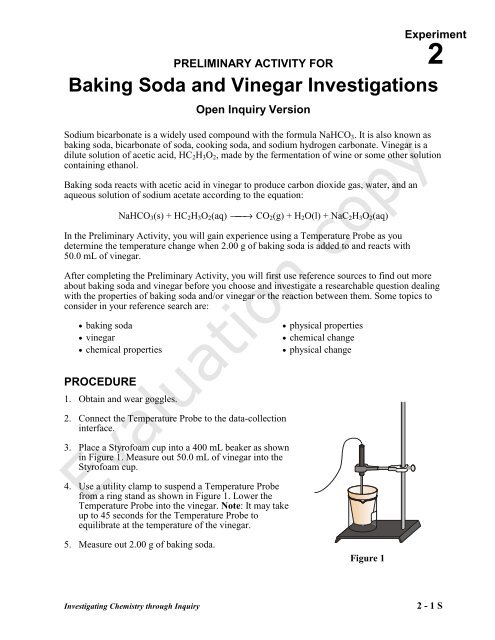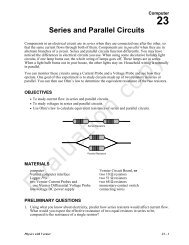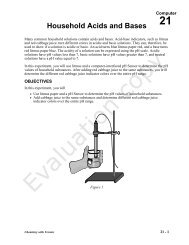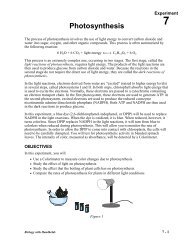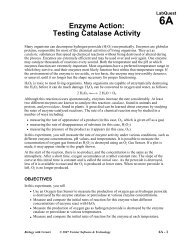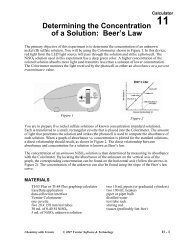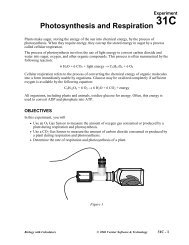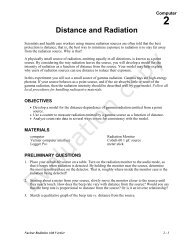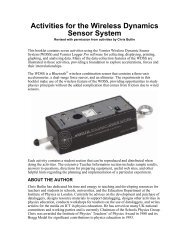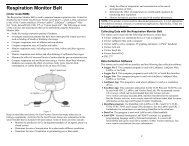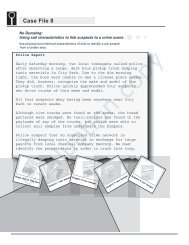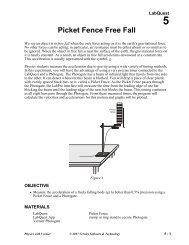Baking Soda and Vinegar Investigations - Vernier Software ...
Baking Soda and Vinegar Investigations - Vernier Software ...
Baking Soda and Vinegar Investigations - Vernier Software ...
You also want an ePaper? Increase the reach of your titles
YUMPU automatically turns print PDFs into web optimized ePapers that Google loves.
Experiment2PRELIMINARY ACTIVITY FOR<strong>Baking</strong> <strong>Soda</strong> <strong>and</strong> <strong>Vinegar</strong> <strong>Investigations</strong>Open Inquiry VersionSodium bicarbonate is a widely used compound with the formula NaHCO 3 . It is also known asbaking soda, bicarbonate of soda, cooking soda, <strong>and</strong> sodium hydrogen carbonate. <strong>Vinegar</strong> is adilute solution of acetic acid, HC 2 H 3 O 2 , made by the fermentation of wine or some other solutioncontaining ethanol.<strong>Baking</strong> soda reacts with acetic acid in vinegar to produce carbon dioxide gas, water, <strong>and</strong> anaqueous solution of sodium acetate according to the equation:NaHCO 3 (s) + HC 2 H 3 O 2 (aq) ⎯ → CO 2 (g) + H 2 O(l) + NaC 2 H 3 O 2 (aq)In the Preliminary Activity, you will gain experience using a Temperature Probe as youdetermine the temperature change when 2.00 g of baking soda is added to <strong>and</strong> reacts with50.0 mL of vinegar.After completing the Preliminary Activity, you will first use reference sources to find out moreabout baking soda <strong>and</strong> vinegar before you choose <strong>and</strong> investigate a researchable question dealingwith the properties of baking soda <strong>and</strong>/or vinegar or the reaction between them. Some topics toconsider in your reference search are:• baking soda• vinegar• chemical propertiesPROCEDURE1. Obtain <strong>and</strong> wear goggles.2. Connect the Temperature Probe to the data-collectioninterface.3. Place a Styrofoam cup into a 400 mL beaker as shownin Figure 1. Measure out 50.0 mL of vinegar into theStyrofoam cup.4. Use a utility clamp to suspend a Temperature Probefrom a ring st<strong>and</strong> as shown in Figure 1. Lower theTemperature Probe into the vinegar. Note: It may takeup to 45 seconds for the Temperature Probe toequilibrate at the temperature of the vinegar.• physical properties• chemical change• physical changeEvaluation copy5. Measure out 2.00 g of baking soda.Figure 1Investigating Chemistry through Inquiry2 - 1 S
Experiment 26. Start data collection. After 3–4 readings at the same temperature have been plotted, carefullyadd the baking soda to the cup. Stir the reaction mixture gently.7. When the temperature readings stabilize, stop data collection. Otherwise, data collection willstop after 180 seconds.8. Use the Statistics function to display the minimum <strong>and</strong> maximum temperature readingsduring the reaction. Record these values (to the nearest 0.1ºC).9. Rinse <strong>and</strong> dry the Temperature Probe, Styrofoam cup, <strong>and</strong> stirring rod. Dispose of thesolution as directed.QUESTIONS1. Subtract the initial temperature from the final temperature to determine the temperaturechange, Δt, for the reaction.2. Which substance is in the bubbles that are produced as baking soda reacts with vinegar?3. List two physical properties of baking soda.4. List two physical properties of vinegar.5. List two observations evidencing that a chemical change took place when you added bakingsoda to vinegar in the Preliminary Activity.6. List at least one researchable question concerning the chemistry of baking soda <strong>and</strong> vinegar.Note: The plan that you submit for instructor approval should list laboratory safety concerns,including chemical safety concerns, <strong>and</strong> specify how you will address these safety concernsduring your investigation.2 - 2 S Investigating Chemistry through Inquiry
<strong>Vernier</strong> Lab Safety Instructions DisclaimerTHIS IS AN EVALUATION COPY OF THE VERNIER STUDENT LAB.This copy does not include:• Safety information• Essential instructor background information• Directions for preparing solutions• Important tips for successfully doing these labsThe complete Investigating Chemistry though Inquiry lab manual includes 25 inquiry-basedlabs <strong>and</strong> essential teacher information. The full lab book is available for purchase at:http://www.vernier.com/cmat/chemi.html<strong>Vernier</strong> <strong>Software</strong> & Technology13979 S.W. Millikan Way • Beaverton, OR 97005-2886Toll Free (888) 837-6437 • (503) 277-2299 • FAX (503) 277-2440info@vernier.com • www.vernier.com


